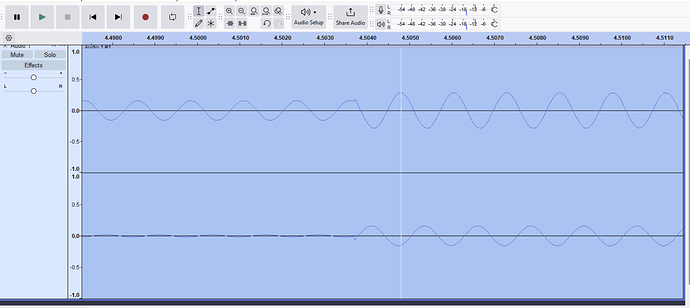-
The B50 bass Deep Bass function on the go control app seems to be set at around 30% intensity by default. This can be too much depending on the speakers being used. It would be good if the intensity can be adjusted from the app. Currently I use the ACP workbench tool to adjust the bass intensity to 15% but it would be nice if the GoControl app had a similar option.
-
The Classical preset in GoControl seems to be adding 3D effect and harmonics to some degree when selected. This is my preferred listening preset and I am curious what effects are being applied when it i selected. It would be nice to have access to the harmonic excitation and 3D music effects from the GoControl app directly as opposed to using the ACP tool.
-
Changes made in GoControl do not show up in the ACP tool and vice versa. It would be good if settings read the same in both apps to avoid confusion as to exactly which adjustments are being made.
-
It would be nice if a custom IR code for volume adjustment be added to the B50. Ideally this would be managed through GoControl. The user would input the code signature in the GoControl app that corresponds to some buttons presses from a different remote control.
The B50 sounds amazing when it is dialed in and adjusted to the speakers and room.
3 Likes
In my opinion there are two standout features of the DSP chip used in Arylic products.
3D and Harmonic excitation. These 2 effects can dramatically improve sound stage and vocals of music. Unfortunately, these settings are not accessible out of the box.
I guess most Arylic customers never adjust these settings as it requires ACP workbench and windows. If adjustment of these parameters were possible through the GO Control app then more people could easily experience a more enveloping sound stage.
Increases sales will offset ACP workbench revenue.
I agree with your suggestions here. I’m a new Arylic BP50 owner and making these changes would probably make the experience for customers greater in general, especially making all the settings accessible through Go Control app as well. I use my BP50 at the computer so it doesn’t affect me but I have to say I was positively suprised by how good the MV3D filter sounded expanding the stage but also imaging, sounds like the sounds are better separated from each other with more clear cues where the sound moves at in 3D space (imo it needs to be set to 91-92% to sound right/natural but I guess it will slightly vary depending on headphone or setup you are using etc). Also the simple setting “Output mode” that is default set to “Stereo” is just another setting I love with these products, it makes the soundstage ever so slightly less “in-your-face” and more speaker stereo like sounding, disabling “output mode” makes it sound more like typical external DACs, somehow for example built-in Realtek onboard sound on motherboards has a more similar sound with that Arylic setting turned on and I always like that, so much I had trouble properly enjoying expensier DACs because of that “in-your-head” sound (I say this as a RME ADI-2 DAC fs owner) and currently running BP50 a source/pre-amp into the RME ADI-2 DAC fs and the soundstage is very vast and deep without sounding artifical in the least, more like using an open-back headphone with great natural soundstaging capabilities but using a closed headphone.
Nice to know that the MV3D effect works well with headphones also.
I usually listen through floor standing speakers notice that tone and reverb are not adversely affected by MV3D whereas stage, separation and envelopment improve dramatically. My understanding is that MV3D employs some form crosstalk cancellation filter (XTC) similar to RACE etc. Maybe Arylic can enlighten us?
RGRM-RACE_rev.pdf (filmaker.com)
If anyone is interested in testing out XTC effects, then this Windows browser plugin is an easy way to get started.
Web Extension Addon | Magic.Audio
The attached image shows cross talk cancellation in action on a MV Silicon DSP chip on a generic BP1048 USB dac dongle. (This type of processing probably applies to Stereo Speakers only and not headphones.)
This picture is from Audacity and shows an 800 Hz LHS mono sine wave fed through the BP1048 with the XTC filter enabled (MV3D).
At the10% XTC setting there is slight boost to the amplitude of the left channel and a small amplitude inverted and offset signal shows up on the right channel.
At the100% XTC setting there is major boost to the amplitude of the left channel and a relatively large inverted and offset signal shows up on the right channel.
Edit, after looking some more this feature may not be working in Arylic firmware for some reason.
After looking some more, it appears that there are two types of 3D effects that can be implemented in the BP1048 (BP1064) DSPchips.
For example, the BRU3P device allows adjustment of Music 3D and Music 3D Plus.
The Music 3D is an XTC filter and plays a noise cancelling sound from the opposite speaker to cancel cross talk.
The Music 3D Plus is a different type of effect and does not use obvious cross talk cancellation. It may be that the timing of various elements in the sound stage are adjusted to increase the depth and width.
The Music 3D effect seems to work well in a narrow listening area but can sound a bit fake whereas the Music 3D Plus effect is subtle and more convincing over a wider listening area.
The Music 3D Plus effect may be the one that is included in the Arylic devices.



